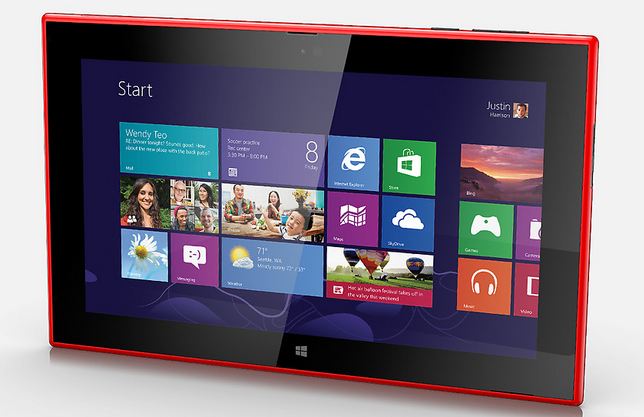The Nokia Lumia 2520: My week with the 'other' Windows ARM tablet

There are two Windows tablet makers still building ARM-based devices: Microsoft and Nokia.

Over the past week, I've had the chance to try out the "other" ARM tablet: The Lumia 2520. Nokia loaned me a device on November 15 and I've been checking it out ever since.
Right off the bat, I can't help but mention that Nokia loaned me (and other reviewers, I believe), the Lumia 2520 without a keyboard/cover combo, as that accessory wasn't ready in time. I admit, the lack of a keyboard colored my "non-reviewer's" review of this device substantially. And not in a good way.
Due to the way I've come to use my Surface RT, Microsoft's first-generation ARM-based tablet, I've come to count on a keyboard as part of my tablet experience, even for casual Web surfing. Yes, I know some of my ZDNet colleagues consider this a mental deficiency on my part. But a real keyboard, like the Type Cover 2, which I recently purchased to complement my Surface RT, has changed my tablet usage patterns noticeably. I pick up my Surface RT a lot more frequently than I did my iPad, as I like the option of typing quickly and comfortably, even for the most mundane tasks.
The Lumia 2520 without a real keyboard/kickstand was just not an optimal experience. The keyboard/cover, pictured at left, is a wrap-around, with the touch pad made of a flexible material. The keyboard/cover is a power one, and Nokia claims it adds up to five extra hours of battery life. The keyboard also adds kickstand functionality to the device.
Missing keyboard/cover aside, the 2520 is a really pretty tablet. It's thin, relatively light (1.36 pounds, or 615 grams), available in four colors, and -- best of all, supports 4G/LTE. Here's a list of specs of the Lumia 2520 and the Microsoft Surface 2 compared.
I didn't think I'd really missed LTE support on my Wi-Fi-only Surface RT. I was wrong. I know there's Microsoft telemetry data that purportedly supports the idea that LTE isn't really wanted/needed by the majority of tablet users. But robust Wi-Fi is not ubiquitous. I found myself happily relying on the Verizon LTE support built into my Lumia 2520 loaner more often than not. I've used it in a variety of places around the U.S. and found it fast and reliable.
After using an LTE-enabled Lumia 2520, I wish I had LTE support in my Surface RT. (Microsoft has said LTE-enabled Surface 2s are coming in early 2014, but so far, there are no plans for LTE-enabled Surface Pro 2 devices.) Requiring users to have MiFi devices or tethering access isn't enough.
I am a "normal" -- compared to many reviewers, at least. That means I don't do benchmarks, unboxings, tear-downs, etc. I just judge devices based on my own usage patterns and past experiences, as an average consumer probably would. From that standpoint, I found the Lumia 2520, which is based on a Qualcomm Snapdragon quad-core ARM processor, to be more "performant" than the Surface RT or Surface 2.
The Lumia 2520 felt as though it opened apps more quickly and allowed me to browse the Web faster than Microsoft's Surface RT or Surface 2 ARM tablets. And for whatever reason(s), the battery on this device seems to be lasting longer than on my Surface RT, from which I get about six to seven hours of occasional (non-constant-streaming) usage. Because of the lack of a keyboard, I haven't used the Lumia 2520 enough to feel comfortable providing a more specific battery-life estimate. Nokia, for its part, claims the device gets up to 11 hours.
While the display on the 2520 is good-looking, I was hard-pressed to notice a differeence between the screen resolution of the Surface RT and the Lumia 2520. The Lumia 2520 sports a higher resolution and ships with a 10.1-inch 1080p display. (The second-generation Surface 2 also offers 1080p.) But I still find documents very readable on my 768p Surface RT. Putting the Lumia 2520 and the Surface RT side-by-side, I had trouble noticing a difference in quality of images or typefaces.
I don't have much more to say about the Lumia 2520. Once I get to try this device out with a keyboard/cover, I most likely will use it more and have more to say about how it compares to my Surface RT.
Here in the U.S., Verizon will be selling the 2520 first, as of November 21, for $499. (It's $399 for those signing a two-year contract). AT&T will offer the 2520 as of November 22 for $399.99 with a two-year agreement. (It's $199.99 for those who purchase it along with certain new Lumia phones.) The keyboard/cover, when available, will be an additional $149.99.
Update (November 22): Nokia is offering a limited-time deal on the keyboard/cover for the Lumia 2520. If you order by January 31, it will arrive via mail for free. "Allow up to six weeks for shipment," according to the deal site.